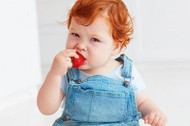Choking in Babies & Kids: 5 First-Aid Tips for Parents
Nov 8th 2024
Choking is one of the leading causes of death in children. It’s also the kind of emergency that can sneak up on a family in the most innocent of moments. How parents handle such an incident is all about preparation, and preparation is big for us here at Dechoker.
Here are our top five tips for choking prevention and first aid. As parents and medical professionals ourselves, these are the tips we believe every family should know.
1 - Start with prevention.
Parents of babies and toddlers know how much little ones like to put things in their mouths. It’s surprisingly easy for these items to get caught in a child’s tiny airways. Searching for choking hazards is an important part of keeping your baby safe. Check out our list of five common household choking hazards, and remember that food is the biggest danger of all. Watch your children closely when they’re eating foods such as hot dogs, grapes, carrots, nuts, raisins, hard or gummy candy, and peanut butter, as these pose the most risk. Also, involve the whole family in prevention. Educate everyone in your home about choking and its dangers, and remind older siblings why it’s important to pick up small toys.
2 - Keep calm.
No matter how hard we try to prevent choking emergencies, they can still occur. If one happens to your family, keep calm. Yes, that sounds easier now than it will be in the moment, but remember that you are prepared. Remaining calm helps your child not to panic, which can make a choking emergency worse. Take a breath, then follow these next steps.
3 - Identify whether the child is in fact choking.
If a child is coughing or gagging, that means the airway is likely only partially blocked. In this case, it’s best to wait and see whether the object will come dislodged on its own. If the child cannot speak, cry or cough, it’s time to act fast. Call 911, or ideally have someone else call, then take action. Do not try to remove the object with your fingers unless it is clearly visible in the child’s mouth, as it could become lodged further in the airway.
4 - Administer first-aid treatments such as the Dechoker.
If your baby or toddler is choking, first-aid treatments such as abdominal thrusts (the Heimlich maneuver), back blows and CPR are the next steps. Also, a life-saving anti-choking device like the Dechoker is an additional first-aid option we believe should be in every family home and first-aid kit. Parents apply this simple device to the mouth of the choking child and pull back on the plunger, which uses suction to dislodge the trapped object. In many cases, the airway is cleared within seconds. We recommend parents learn all they can about infant choking, CPR and other first-aid treatments, as well as keep a Dechoker on hand and easily accessible. This way, you will have many tools at your fingertips should an emergency arise. Learn more about how the Dechoker works here.
5 - Seek aftercare.
If your child had a minor choking incident in which he or she was able to cough up the object, you likely don’t need to seek further health care. If there was a true choking emergency, however, it’s best to check in with a health professional. Let emergency personnel examine your child or visit a doctor or ER, especially if your child is having any issue with breathing or swallowing after the incident.
We congratulate you for being proactive about your family’s safety in reading up on choking risks and treatments.

